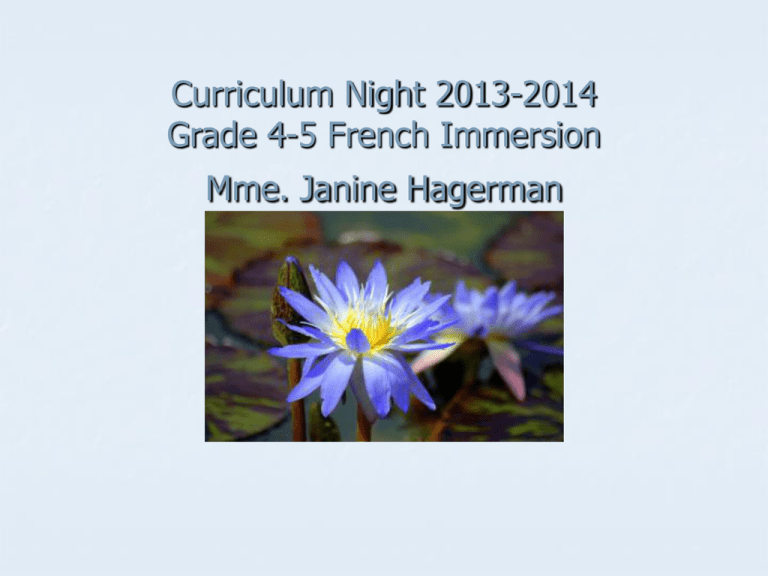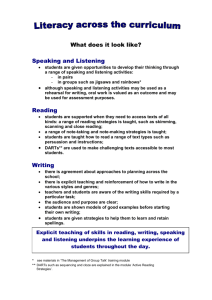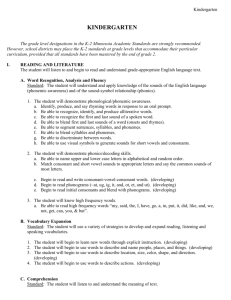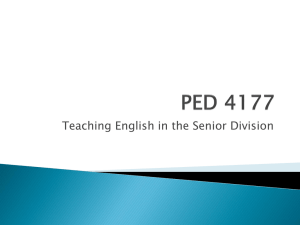Curriculum Night 2011 Grade 5 French Immersion
advertisement

Curriculum Night 2013-2014 Grade 4-5 French Immersion Mme. Janine Hagerman Specialist Schedules Tuesday: Thursday: Phys. Ed and Music Library Book Exchange Phys. Ed and Music Friday: Phys. Ed Homework Homework assignments will be designed to extend and compliment lessons and concepts learned in class. Where indicated, the students will be able to select either a Grade 5 or Grade 4 level of assignment. Daily Reading Logs : The students will be asked to have a “just right” French book at home to read at least 4 nights per week. A record of this reading will be rewarded in class. Assignments will be given on Tuesday, and collected the following Monday. The Homework Binder is also a communication tool. It will need to be in the school bag every day. Expectations For a Positive Learning Environment Respect is the key word. We come together at the beginning of the school year to agree on the best choices of behavior that will help self and others learn. Our class rules are posted and reinforced daily. Seaside’s Code of Conduct is found in a Matrix. Please find this in your child’s Agenda. PEBS Our daily reward language is expressed in “High 5s”. A High 5 is given to students who exemplify attention to all of the expected learning behaviors taught in class. Fantastic Friday phone calls: Health: Term 1: Healthy Relationships to self and others Term 2: Healthy Community Term 3: Healthy Self French Language Arts Appreciation of the French language and of cultural diversity; Students need to demonstrate a positive attitude toward the French language and towards Francophone communities throughout Canada and around the world. They need to respect and recognize cultural diversity French Language Arts Example of an assessment tool ; L’élève Speaks to his/her friends, the teacher and visitors in French Uses French in a variety of situations Avoids using English, using strategies to solve Demonstrates interest in improving his/her French Uses vocabulary and expressions modeled in class. Souvent Parfois Rarement French Language Arts Special projects that will enhance student appreciation of culture and language; - use of electronic penpals “Epals” or Skype partners - a unit of study on children around the world with a focus on the Rights of the Child ( UN) and on how these rights are and are not upheld in various contexts. - special guests - field trips. - frequent airing of French media in class French Language Arts Listening and Speaking - The students will learn specific strategies to help them anticipate the meaning of what is spoken in French. - They will learn specific listening behaviors, which tie in to the overall goals of the school’s and class’s codes of conduct, with an emphasis on respect. - Students will accumulate, through teacher modeling, several ways to use French vocabulary and sentence structures, without resorting to using English. - The teacher will correct language only using judicious means, never singling out an error made by a particular student. French Language Arts Listening and Speaking, cont’d Students are guided towards several in-class resources while using their listening and speaking skills in French. The development of a repertoire of resources is part of the student’s skill set in communicating in French. Assessment tools: Checklists Oral presentations Class participation in discussions Rubrics Listening tasks where the main idea and details need to be extracted and noted Samples of student responses to oral texts Anecdotal notes French Language Arts Reading and Viewing Students need to develop comprehension strategies in various reading contexts; Read Aloud Shared Reading Independent Reading Guided Reading French Language Arts Reading and Viewing; Students will read for various purposes; For pleasure, for information, for the sake of critical analysis … They need to demonstrate their understanding of text through a variety of means, such as a Reading Journal, Book Talk, Book Club, responses to procedural texts, personal reactions…. The use of graphic organizers is strongly encouraged. French Language Arts Reading and Viewing; Texts will vary in how they are presented. They may be films and other visual texts Comprehension strategies include Connections with prior experiences, with personal experience, with other texts, and with events in real life in general ( the world) Wondering…. Visualizing Making Inferences Transforming thought.. French Language Arts Reading also involves the analysis of; the author’s intent, point of view, bias and stereotyping, accuracy of information, usefulness of text, effectiveness of text layout…. This critical thinking is highly valued in Grade 4-5 French Language Arts Writing and Representing Writing will be integrated throughout the day across the curriculum. Writer’s Workshops will be held to teach the craft of writing as well as to address all technical and theoretical matters, in the form of mini-lessons… A strong emphasis is on the process of developing quality writing, over the actual product. Some pieces will be selected to be brought through to the “ publication” stage. French Language Arts Writing… Grammar and spelling are emphasized throughout the process, where mini-lessons address specific grammatical difficulties, and practice is required for students to improve. Spelling is addressed in the form of word-study; examining prefix, suffix, root, word families, phoneme families, words that have roots in other languages, words that are similar to the English. English Language Arts Listening and Speaking: Developing maturity in social interactions, by showing respect for the ideas, thoughts and opinions of others, by developing strategies to listen attentively, and knowing how to engage in discussion by taking turns. As the year progresses the expectations shift to attending to and using specific vocabulary, listening and responding critically, and giving oral presentations. English Language Arts Reading and Viewing: Showing the ability to select “Just Right” books that are appropriate for reading level, expanding interests, by reading “widely” from a variety of genres, and engaging the behaviors that show that “Reading is Thinking”, such as taking notes of thoughts, feelings, and impressions. English Language Arts Reading This year the students will read for the purpose of answering “research” questions. They will expand on note-taking skills, will learn to find information from many sources, books, internet, interview, magazines… They will be learning the conventions of information text in particular during this time. English Language Arts Reading: Students will be developing comprehension strategies that will help them with; making connections with prior knowledge, wondering, visualizing, making inferences ( reading between the lines) and transforming their thinking. They will be expanding on their vocabulary. They will be developing greater fluency and accuracy . English Language Arts Writing: Using the Writer’s Notebook, students will collect ideas as “seeds” of eventual writing. They will be writing personal narratives, will be experimenting with writing in various genres. They will work through the process of writing with an emphasis on pre-writing skills; selecting ideas, organizing with/without the use of graphic organizers, and outlining their drafts. English Language Arts A note about SPELLING…….. Within the context of reading and writing workshops, we will be looking at spelling conventions. Word study activity will be extended into practice at home. Students will be asked to keep up a word bank in class to assist them in writing words they frequently encounter and need . Mathematics Mental Math: (Time limited tasks) Addition and Subtraction Facts Multiplication and Division Facts Estimation Visual-Spatial Discrimination Geometry: Mathematics Term 1: Whole Number Sense Decimal Number Sense Operation Sense with Addition, Subtraction, Multiplication Measurement: Perimeter, Area Data Management: Stem and Leaf, Double Bar and Pictographs Mathematics Term 2 Number Sense with Fractions and Decimals Operation Sense: Additions, Subtraction, Multiplication and Division 3D Geometry : Motion geometry Measurement: Standard International units, Data Management: Line graphs and Coordinate Graphs Mathematics Term 3 Geometry: Angles, Triangles, Quadrilaterals Measurement: Angles Data Management: Double Bar graphs Probabilities Sciences humaines Grade 5 Grade 4 Time, Continuity and Change Interactions The Nature of Exploration People, Place and Environment Ancient Societies Exploring our World Interdependence Social Structure of Medieval Societies Exploring the Landscapes of Canada ( Human and Political) Citizenship, Power and Governance Governance Physical Landscape of Canada. Sciences humaines Assessment: Modes of collecting information on student understanding are varied. Project: My Treasure Box and Personal Timeline Note-taking: Organizing information in tables, charts, using graphic organizers Class participation Role plays Oral presentations Jigsaw cooperative learning situations Tests Attitude and class behaviors Sciences Grade 5 The Human Body Ecosystems: Observing weather, climate and habitat Forces and Simple Machines-Light and Sound Rocks and Minerals/Matter ( properties and changes ) Science Grade 4 Rocks and Minerals Light Sound Habitats Art Term1: Express themselves in relation to the world through art-making Compare art across time ( link to Social Studies Unit on Exploring History and Ancient Civilizations) Use a combination of the visual elements and principles of art and design in art-making Develop ability and initiative in the use of techniques Art Term 2: Collaboratively to apply learned skills, solve problems and express ideas. Discuss ideas and approaches with sensitivity and respect Demonstrate that there are many ways of perceiving and knowing Use appropriate language in expressing their own responses to artworks Demonstrate a sensitivity towards the natural and built environment through their artwork Art Term 3: Contrast personal styles of a variety of artists Describe art and the lives of artists within cultural/historical/social contexts Examine the role of the media and discuss its effects on their lives Questions? You can find all curriculum resources in the Document Depot of the Nova Scotia Department of Education





![to Learning Styles Questionnaire [MS Word,93Kb]](http://s3.studylib.net/store/data/007287401_2-741c6340dee171d22423967f2d0c2716-300x300.png)


